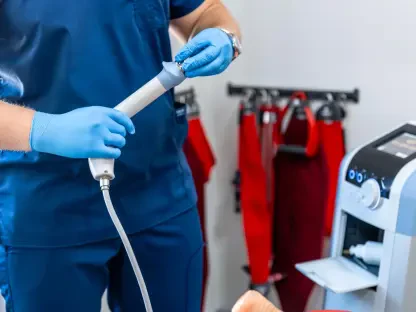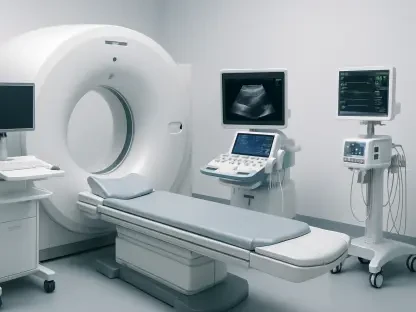Essential tremor affects approximately seven million people in the United States, causing involuntary rhythmic muscle contractions that can severely impact daily life. Unlike Parkinson’s disease, essential tremor is defined by these rhythmic movements, particularly in the hands. Traditional treatments for this condition often include oral medications, which can be unsatisfactory, offering limited relief. More effective treatments like deep brain stimulation and focused ultrasound exist, but these require invasive surgical procedures, making them less desirable options for many patients.
Innovative Treatment With the Felix NeuroAI Wristband
AI Integration and Real-Time Feedback
The Felix NeuroAI wristband by Fasikl represents a significant advancement in treating essential tremor, offering a non-invasive alternative that uses artificial intelligence (AI) to provide personalized therapy. The device works through real-time feedback, continuously adapting to the wearer’s needs. By studying the user’s tremor patterns, the wristband adjusts its therapeutic approach, providing targeted treatment without the need for surgery. This adaptability is crucial for managing varying severities and types of essential tremor, offering a custom-tailored method that meets individual needs.
The TRANQUIL study, a multicenter double-blind, sham-controlled trial, included 125 adults in the United States and China, randomly assigning participants to receive either the Felix NeuroAI wristband or a sham device over a period of 90 days. The primary endpoint was measured by the change in the modified Activities of Daily Living score (mADL) from the Tremor Research Group Essential Tremor Rating Assessment Scale (TETRAS). Results demonstrated that patients using the Felix NeuroAI wristband experienced a clinically significant improvement, with a mean reduction of 6.9 points on the mADL scale. This contrasts sharply with the 2.7-point reduction observed in the sham group, underscoring the wristband’s effectiveness.
Comprehensive Study Results and Impact
Participants in the TRANQUIL study spanned various demographics and levels of tremor severity, providing a broad assessment of the wristband’s effectiveness. Treated patients consistently reported improved symptoms and enhanced quality of life, a testament to the wristband’s efficacy across diverse populations. Importantly, no serious adverse events related to the device were reported, indicating that the wristband is safe for widespread use. These findings were presented at the American Academy of Neurology (AAN) Meeting in San Diego, marking a notable moment in the landscape of essential tremor treatment.
Dr. Rajesh Pahwa, a principal investigator in the TRANQUIL study, emphasized the significance of these findings. He highlighted the limitations of current oral medications and the invasive nature of surgical options, suggesting that the Felix NeuroAI wristband could revolutionize essential tremor treatment. By offering a non-invasive alternative that delivers personalized therapy through AI-driven technology, the wristband stands to improve the quality of life for many patients who have had limited options until now.
Other FDA-Cleared Devices and Comparisons
Evaluating Alternative Treatments
While the Felix NeuroAI wristband is making headlines, it is important to consider the broader context of essential tremor treatments. Other FDA-cleared devices, like Insightec’s Exablate Neuro platform and Cala’s wrist-worn device, also provide non-invasive options. Each device uses different methodologies to target essential tremor, with varying degrees of success and patient satisfaction. For instance, the Exablate Neuro platform uses focused ultrasound to treat tremor by destroying the brain tissue causing the abnormal movements. Meanwhile, Cala’s wrist-worn device employs electrical stimulation to disrupt abnormal brain signals.
Despite these advancements, the Felix NeuroAI wristband stands out due to its continuous adaptability and real-time adjustments based on AI analysis. These features position the wristband as a potential new standard in personalized care for essential tremor patients, significantly differing from static treatment methods. The adaptive nature of the Felix NeuroAI wristband ensures that therapy is consistently optimized, providing better outcomes over time without the need for repeated surgical interventions or constant medication adjustments.
Potential for Widespread Adoption
The potential for the Felix NeuroAI wristband to become widely adopted hinges on several factors, including accessibility, ease of use, and overall patient outcomes. Patients have reported not only improved symptoms but also enhanced daily functioning and overall quality of life. This points to the device’s practical benefits beyond the clinical improvements noted in studies. The combination of effectiveness, safety, and patient satisfaction positions the Felix NeuroAI wristband as a promising addition to essential tremor treatment options.
Furthermore, its non-invasive nature eliminates the risks and recovery time associated with surgery, making it a more appealing choice for many individuals. As awareness and availability of the wristband increase, it is likely that more patients will opt for this innovative treatment. Healthcare providers may also favor recommending such non-invasive solutions due to their lower risk profile and ease of implementation.
A New Era in Essential Tremor Treatment
The development of the Felix NeuroAI wristband marks a significant milestone in the fight against essential tremor. Its AI-driven approach represents a shift towards more personalized and adaptive healthcare solutions, aligning with broader trends in medical technology. By continuously learning and adjusting to the needs of individual patients, the wristband offers a level of precision that static treatments cannot match. The TRANQUIL study’s results provide strong evidence of its efficacy and safety, laying the groundwork for broader clinical adoption.
Future Implications and Considerations
Moving Towards Personalized Medicine
As the Felix NeuroAI wristband gains traction, it underscores the growing importance of personalized medicine in treating chronic conditions. The ability to tailor treatments to individual patient needs through real-time data analysis is a powerful tool, offering a model for future innovations. This approach can be extended to other neurological disorders, potentially transforming treatments for conditions like Parkinson’s disease, epilepsy, and multiple sclerosis.
The success of this wristband encourages further investment in AI-driven healthcare technologies, driving advancements across different medical fields. The hope is that such personalized treatments will become more commonplace, improving outcomes and quality of life for a broad spectrum of patients. By reducing dependency on one-size-fits-all approaches, the healthcare industry can look forward to more effective management of diverse conditions.
Considerations for Broader Implementation
While the wristband’s potential is clear, several factors must be considered for broader implementation. These include ensuring the affordability of the device, integrating it into standard care practices, and educating both healthcare providers and patients on its use and benefits. Collaboration between healthcare providers, patients, and tech companies will be crucial to overcoming these challenges and maximizing the benefits of this innovative treatment.
Regulatory bodies will also play a role in overseeing the safety and efficacy of such devices, requiring ongoing research and monitoring to maintain high standards of care. Provided these hurdles can be effectively managed, the Felix NeuroAI wristband has the potential to significantly enhance the standard of care for essential tremor patients and serve as a beacon for future technological advancements in health treatment.
Conclusion
Essential tremor impacts around seven million individuals in the U.S., triggering involuntary rhythmic muscle contractions that can greatly disrupt everyday life. Unlike Parkinson’s disease, the hallmark of essential tremor is these rhythmic, involuntary movements, especially noticeable in the hands. Traditional treatment methods typically involve oral medications, which often fail to provide substantial relief and can be unsatisfactory for many sufferers. There are, however, more effective treatments available, such as deep brain stimulation and focused ultrasound. Nonetheless, these options involve invasive surgical procedures, which make them less appealing or suitable for a significant number of patients who may prefer less intrusive solutions. Exploring and developing alternative therapies that strike a balance between efficacy and non-invasiveness remains crucial for improving the quality of life for those affected by essential tremor.









